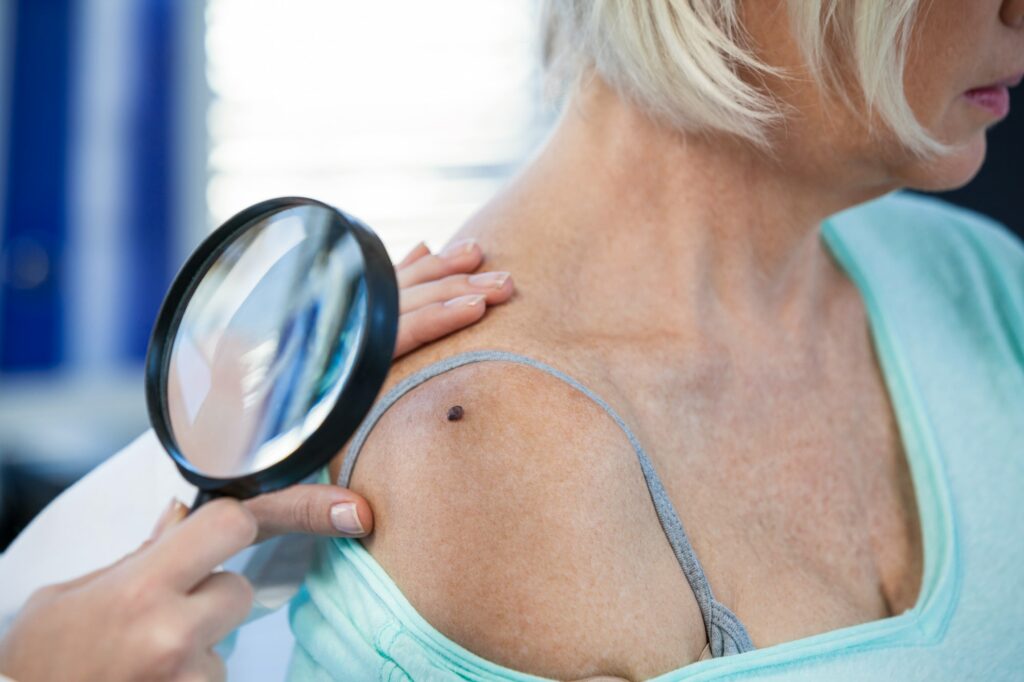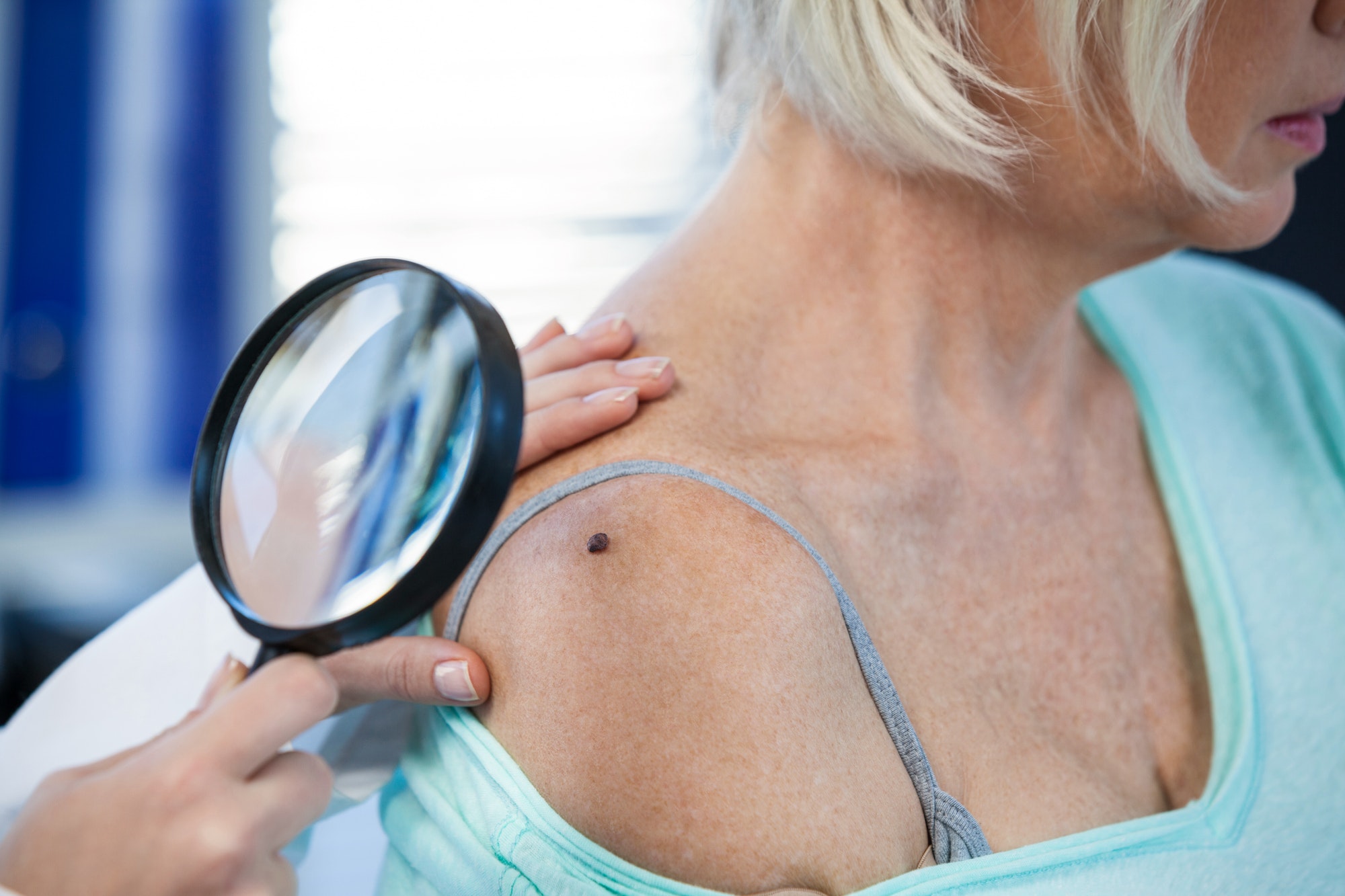Skin cancer, though easy to fully treat early on, is one of the most complex and serious conditions treated by dermatologists.
Skin cancer affects 20% of Americans and is an extremely common form of cancer, so knowing the proper protocol and prevention could save your life!
This article will be spread out across three main sections, risk factors and preventative measures, prevention and detection, and treatment options.
Understanding our skin
The skin is the body’s largest organ, protecting against natural exposures and injury, controlling body temperature, storing important molecules, and more. The skin has two main layers, the epidermis (upper or outer layer) and the dermis (lower or inner layer.)
Mutations of DNA skin cells cause them to grow and form a mass of cancer cells beginning in the epidermis, which is the thin, protective top layer of the skin. These cells can start as pre-cancerous but evolve into cancerous ones over time.
Risk factors and preventative measures

What is the biggest and most common risk factor for skin cancer? Can you manage your risk of skin cancer?
Manageable and controllable factors come down to exposure to sunlight and UV rays. The biggest hammering UV agents are tanning beds, sunlamps, and natural sun exposure.
UV damage accumulates over your lifetime and doesn’t just occur under direct and intense sunlight.
UVA and UVB rays can both damage your skin and possibly lead to and expedite skin cancer, so it’s important to apply a broad-spectrum sunscreen frequently.
Can skin cancer develop without skin exposure? Can you get skin cancer without sun exposure?
There are risk factors that put certain individuals at higher risk of skin cancer, independent of their sun exposure.
Some people have a genetic predisposition to certain types of skin cancers as well.
One set of risk factors would be lighter hair, eyes, and skin. This is because less melanin is present to protect them from the sun.
There are broad genetic risk factors that can’t be controlled, such as age, family history of skin cancer, or the aforementioned pigmentation.
Exposure to certain toxic substances can increase your risk of developing skin cancer, such as arsenic, tar, paraffin, solvents, and vinyl chloride. Exposure to toxic substances or immune-weakening conditions can also contribute to the risk of skin cancer.
Lastly, smoking can also increase the risk of cancers by damaging the skin.
Can you get skin cancer from radiation treatments?
Prevalence of moles, some skin conditions (eczema, psoriasis, and others), and immunocompromising diseases like HPV/AIDS, leukemia, and radiation exposure increase the likelihood of developing skin cancer.
Do chemical peels prevent or cause skin cancer?
Chemical peels are used to treat aesthetic and medical skin conditions. However, these treatments can also cause UV sensitivity, which is why clinicians will recommend being extra cautious and avoid the sun before and after treatments.
Although it’s said that getting chemical peels regularly can actually prevent skin cancer, it’s also important to be safe about how it’s being done, as well as how you prepare before and after the treatment.
Professional chemical peels have been shown to effectively treat precancerous conditions like actinic keratosis, by removing dangerous or damaged cells which lowers the risk of them turning malignant.
These clinical usages of chemical peeling to prevent skin cancer make the conclusion complicated.
Certain chemicals in peels, like TCA (trichloracetic acid), were found by studies to be linked to cancers in animals. There is a possible link between chemical peeling and skin cancer but has not been proven in any human studies.
You can read more about the nuances of this relation in this summary on chemical peels and skin cancer or in this article about the historical studies of TCA.
Do laser treatments or IPL treatments cause skin cancer?
Other types of cosmetic treatments involving artificial lights like laser treatments (IPL) also are not shown to cause cancer. There has been no medical evidence for this linkage. The important caveat is that these types of focused treatments can make your skin more vulnerable to UV exposure, and will normally require avoiding sunlight before and after treatments.
Receiving incorrect treatment using lasers by inexperienced or non-qualified operators can remove or hide undiagnosed symptoms of melanoma or other skin cancers. This leads to these cancers remaining undetected until treatment is too late.
Make sure to go to a verified clinic with trained professionals for these types of treatments, and be cautious of buying these machines on your own.
Do other types of lights cause skin cancer?
Fluorescent or normal household lights that don’t create UV rays will not cause skin cancer. Tanning beds, tanning lights, and indoor sun lamps are the only types of artificial light that create a direct risk for skin cancer.

Can you eat certain foods to prevent skin cancer?
Food is an important energy source for your body. The naturally occurring nutrients in food can have a synergistic effect, which is why consuming an array of healthy, diverse foods creates more internal benefits, heals inflammation, and boosts your immunity.
Nutritional factors can actually reduce your risk for skin cancer. Eating a diet rich in fruits and vegetables that boost your general health can over the long term reduce the risk.
These types of foods have plant-based chemicals called phytochemicals, and these antioxidants can reduce the risk of developing skin cancer.
This article on how certain whole foods can prevent skin cancer covers the different types of antioxidants found in common foods and supplements that can help bolster your defenses.
Are there certain vitamins that prevent skin cancer?
High doses of individual vitamin supplements might not work the same way and could potentially be toxic. However, certain vitamins are important when relating to the skin.
Having an antioxidant-rich diet can help prevent skin cancer and is recommended by many dermatologists. Vitamin C, E, and A, zinc, selenium, beta carotene (carotenoids), omega-3 fatty acids, lycopene, and polyphenols.
Vitamin A is essential for healthy skin cells, so eating a vitamin A diet can bolster your skin against natural risks.
Instead of getting vitamin D from direct sunlight exposure, you can intake vitamin D from your diet. You can eat vitamin-fortified foods like milk and certain products, or vitamin D supplements.
Nicotinamide is a form of over-the-counter vitamin B3 that could potentially prevent skin cancers. Nicotinamide, NSAIDs, polypodium leukotomos, and alcohol reduction are shown to potentially prevent skin cancers.
Is cannabis a viable treatment for skin cancer?
Cannabidiol (CBD) has had a recent buzz in the lifestyle and general wellness sphere. It’s shown to be effective in easing numerous medical conditions, and even cancers. A good amount of research has been done on this topic and has shown that CBD oil used in conjunction with other treatment methods can help reduce tumor growth at a high speed.
You can read more highlights on recent research highlights on CBD oil and skin cancer in this article.
Prevention and Detection

How sun protection and sunscreen application prevents skin cancer
Skin cancer develops on skin that is exposed to sunlight.
Most skin cancer is avoidable, and thus it is important to emphasize protection by proper use of sunscreen application and coverage.
You can reduce your risk of skin cancer by limiting exposure to ultraviolet (UV) radiation. UV exposure comes from being in the sun without sunscreen, or tanning beds.
Peeling sunburns puts you at a big risk for skin cancer. Swimsuits actually used to cover the torso, and melanoma increased significantly once the popular bikini style was adopted.
To protect your skin from absorbing natural UV radiation, wearing protective clothing, reapplying sunscreen, and avoiding the sun during the strongest peak hours can all help.
How do you check for early signs of skin cancer?
Let’s go over skin self-examination- one of the best ways you can monitor your skincare and get the proper assessment if noticing any unusual or concerning symptoms.
Checking your skin often is the best way to detect potentially threatening signs. Look for alterations in the appearance of the surface of your skin.
It’s a good idea to examine your skin often for new changes in any existing moles, freckles, bumps, and birthmarks. Getting into the habit of regularly looking at your skin will help inform you of what is normal on your skin.
Moles, birthmarks, or freckles on your body that don’t change or shift over the years are not a cause for concern, but if they do begin to change in size, texture, or color- it is a good indicator to get a professional to check it out.
How often should you check for skin cancer?
Performing regular self-examinations of the skin are recommended. For those who have a family history of melanoma, or personal skin cancer history, the skin should be checked regularly.
It’s a good idea to check once a month for any potential skin cancers. There is no formal or official guideline, but monthly is the frequency that most doctors will recommend.
You can speak to your dermatologist for a personalized evaluation of how often you should be checking your skin, which can depend on your own general health, risk factors, and family history.
Early detection gives you the greatest chance for successful skin cancer treatment. The treatment will work better earlier own, as it reduces the risk of cancerous cells spreading to other tissues and organs.

How do you perform a self-check for skin cancer?
Look at all areas of your body as you stand in front of the mirror. Areas to look for when self-checking are the face, neck, chest, arms and hands, and legs. Skin cancer can form on any area of the body, but these are common areas. Use a hand mirror to see spots that are harder to see, like your lower back or behind your neck.
You can use a full-length mirror as well as side mirrors for difficult-to-reach parts. You can also have a spouse, partner, or close one help you with these screening exams, especially for parts like your back or behind your neck.
Become familiar with any existing skin patterns, blemishes, and birthmarks so that you can look out for changes or mutations in the future, as well as to help you recognize any new occurrences.
If you are unsure of changes, taking photos of the spot can help you see if there are any unusual changes over time. Note any uncomfortable sensations as well, such as pain, itching, or bleeding.
If there are scars that don’t heal in a few months or flat patches of scaly skin that doesn’t go away, you should make an appointment with your doctor.
If you detect any uncommon changes, it’s a good idea to have it checked out by your doctor or at urgent care.
What is the ABCDE rule?
The ABCDE rule is also a handy mnemonic to look for signs of melanoma or skin cancer.
ABCDE stands for asymmetry, border, color, diameter, and evolving features.
Asymmetry issues to look out for are when there is a lack of symmetry, where one side of a mole looks different from the other and isn’t round.
Signs for border issues are when the border is irregular, ragged, or blurred instead of smooth.
Look out for unusual or irregular colors in your moles, spots, or lesions.
Diameter is when the size of the spot begins to change. If moles become larger than one-quarter inch in diameter, they might be cancerous.
Lastly, signs of evolution to look out for are changes in the appearance of spots on your body over weeks or months.
Generally, spots on your body that stand out from others are most suspicious.
Regular checks and any relevant treatment for detected skin cancers is extremely critical. If areas of your skin look irregular or suspicious, you should seek an urgent skin check. Contact CityHealth to book your appointment for your next targeted skin check, and additional treatments can be suggested from there.

Should I schedule professional skin examinations?
If you’ve never had a full-body skin check before by a professional, it’s a good idea to do one as soon as possible. There is no set age for when this should happen, but your dermatologist will be able to do a full baseline check, and then recommend how often you should be self-examining, as well as when you should return.
It’s a good idea to do professional, full-body skin examinations every year following your first initial screening. If you have a history of skin cancer, or any concerning blemishes that need to be monitored, the frequency of in-office meetings might increase.
These examinations are usually brief. You can come to these prepared with notes.
Early detection is key to a lower cost and high effectiveness treatment, with the highest chances of a cure and full recovery. Make sure to schedule an appointment for a full check-up if there are any concerns!
Does skin cancer ever look like ingrown hair?
Skin cancer might look like ingrown hair. However, skin cancer won’t grow from ingrown hair, even if they look similar. There are some differentiators between the occurrence of ingrown hair and skin cancer lesions.
If the area begins to grow, change color or look more infected, or have a sensation of pressure under the skin, that could be a sign of cancer. If you are concerned and unsure how to identify it, scheduling a check-up is always a good idea.
Skin Cancer Awareness and Treatment
What happens if you get skin cancer?
If you’ve detected or been diagnosed with skin cancer, there are plenty of treatment options. The most important is to follow up with your doctor and dermatologist and follow their treatment schedule and recommendations.
Treated early, your doctor or dermatologist can treat it with high odds of eliminating it completely, alongside minimal scaring. Sometimes, skin cancers can be detected and treated at the precancerous stage before it’s penetrated the underlying levels of the skin.
Timely check-ups and screenings could be life-saving!
Is skin cancer a critical illness? How is it treated?
Staging is used to find out if cancer has spread within the skin or to other body parts, and it will determine the stage of the disease. Knowing the stage helps to plan treatment.
Depending on the progress identified during the staging period, tests and procedures will be employed. The prognosis of skin cancer will depend on the stage of cancer, the patient’s general health, and whether the patient is immunosuppressed.
The concurrent treatments will depend on the type of cancer, the stage of cancer, the tumor size and body part presence, and the general health of the patient.
Common treatment methods and tools are a CT scan, a chest x-ray, a PET scan, an ultrasound exam, an eye exam with dilated pupil, or a lymph node biopsy.
How does skin cancer spread?
Cancer can spread by beginning through tissue and growing into nearby areas, entering the lymph system, traveling through lymph vessels to other parts of the body, and then traveling through blood vessels to other parts of the body.
Metastasis happens when cancer spreads to another part of the body. The cancerous cells leave the primary origin point and begin to travel through lymph or blood vessels.
If skin cancer cells spread to other parts of the body, they continue to be the original form of cancer and don’t mutate into other forms of cancer (e.g., breast, lung, or other forms of cancer.)
What happens if you ignore skin cancer?
The progress of skin cancer depends on the type of cancer it is. Some forms of skin cancer can grow rapidly if metastasized and not treated early.
As skin cancer progresses and metastasizes into other stages, it can begin to cause bone or tissue damage. It can spread to distant organs such as the brain, lungs, or liver.
What happens if skin cancer goes untreated?
The more advanced a cancer is, the more intensive the treatment required, and the worse the outlook for treatment.
Some forms of skin cancer typically are not life-threatening, but there can be serious health risks associated with all forms.
What are the main types of skin cancer?
Basal Cell carcinoma, squamous cell carcinoma, and melanoma are the main types of skin cancer.
Basal Cell Carcinoma
Basal cell carcinoma rarely spreads to other parts of the body. It progresses slowly and can be locally destructive.
This is where skin cancer is often formed and is a common type of skin cancer.
Look out for flat, flesh-colored, or brown lesions that look like a scar. Another indication of basal cell carcinoma is bleeding sores that heal as scabs but re-occur.
Squamous Cell Carcinoma
Though also slow-growing and at low risk to metastasize, squamous cell carcinoma can eventually spread to other parts of the skin. These also have the potential to arise suddenly and grow rapidly. They will frequently show up as a hard, red spot or a flat lesion with a scaly surface.
Melanoma
Melanoma is less common than basal and squamous cell cancers but makes up the majority of skin cancer deaths. Melanoma advances quickly and can form and spread to any area of the body. Melanoma occurs in people with dark skin tones, and it’s more likely to appear in areas that aren’t necessarily exposed to the sun.
When looking for melanoma, check for large brown speckled spots, a mole that changes in texture and/or bleeds, lesions with irregular borders that appear red, pink, white, blue, or blue-black, a painful lesion that burns or is itchy, or dark lesions on your palms, soles, fingertips or toes.
 In general, when looking for early signs of skin cancer, follow the ABCDE rule of screening and keep an eye out for changing spots, itching and/or bleeding from spots, and new spots appearing on your skin.
You can learn more about each type of skin cancer and specific signs to look out for in this article by the American Academy of Dermatology Association.
In general, when looking for early signs of skin cancer, follow the ABCDE rule of screening and keep an eye out for changing spots, itching and/or bleeding from spots, and new spots appearing on your skin.
You can learn more about each type of skin cancer and specific signs to look out for in this article by the American Academy of Dermatology Association.
What happens if you ignore melanoma?
Melanoma is not the most common type of skin cancer, but it spreads so can often be more serious and difficult to treat.
The ACS calculated that the likelihood of a 5-year relative survival rate for people with melanoma compared to a person without cancer.
The 5-year relative survival rate is 98% for melanoma patients who seek treatment before it spreads. If it spreads to deeper tissues or nearby lymph nodes, the rate drops to 64%.
If it reaches distant organs or tissues, the 5-year relative survival rate reduces to 23%.
Melanoma can become deadly if untreated for too long or spreading to deeper areas of the skin or body.
The rates of deaths from deadly skin cancers have declined in recent years, because of increased detection and more rapid treatment.
What’s the recommended clinical procedure for skin cancer?
If you are concerned about an early sign of skin cancer, schedule a visit with your dermatologist. It’s often most preferable to see a dermatologist directly, and most skin cancer issues will eventually be referred to a dermatologist. If you don’t currently have a dermatologist, schedule a visit with your primary doctor or urgent care center.
While most early phases of skin cancer are relatively benign and can be handled by a visit to your primary doctor or dermatologist, some symptoms can be red flags that an appointment should be scheduled right away. An expedited appointment can be requested for these cases.
Can I go to the Emergency Room (ER) for skin cancer?
Skin cancer is typically not a condition that requires ER treatment. It can be checked out by your primary doctor, or urgent care but does not require ER visitation.
Emergency room visits are commonly triggered over serious skin infections, but typically an urgent care center can also diagnose and properly treat these immediate issues.
Although some emergency room clinicians may point out previously undetected skin issues that could be a cause of concern, it’s not something that’s commonly treated.
It can be more costly and delayed to get the proper definitive care for skin cancer. A low percentage of skin-related emergency treatments cases are actually classified as an emergency.
If you are undergoing a process of skin cancer treatment, your physician might inform you of when it would be appropriate to seek emergency care. You can also ask them for this recommendation.
What are the treatments for the late stages of skin cancer?
Detection and treatment are extremely important when it comes to skin cancer and cannot be emphasized enough.
If cancer spreads to the lymph nodes, a doctor may request a lymph node biopsy.
Radiation therapy treatments may be recommended in later stages.
Other treatments for extremely progressed stages of skin cancer would be chemotherapy, immunotherapy, and targeted therapy.
Conclusion
Hopefully, you’ve come to a comprehensive understanding of skin cancer, early prevention, detection, and treatment.
Remember, all skin cancers are highly treatable if caught early. If you’re concerned about your skin, contact CityHealth to speak with a specialist today!


 In general, when looking for early signs of skin cancer, follow the ABCDE rule of screening and keep an eye out for changing spots, itching and/or bleeding from spots, and new spots appearing on your skin.
You can learn more about each type of skin cancer and specific signs to look out for in this article by the American Academy of Dermatology Association.
In general, when looking for early signs of skin cancer, follow the ABCDE rule of screening and keep an eye out for changing spots, itching and/or bleeding from spots, and new spots appearing on your skin.
You can learn more about each type of skin cancer and specific signs to look out for in this article by the American Academy of Dermatology Association.







